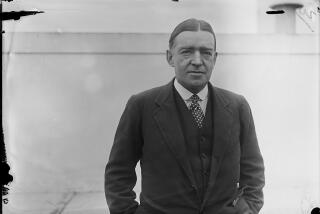Discovery of Explorer LaSalle’s Ship a Treasure-Trove for Archeologists
- Share via
ABOARD THE BELLE, Gulf of Mexico — To archeologists excavating the wreck of one of the explorer LaSalle’s ships, success is finding tiny things like blue glass beads or bronze pins.
But on a really terrific day, a 300-year-old skeleton is discovered in the wreckage, as one was recently. Or the hand guard of an officer’s rapier appears out of the mud that shrouds the ribs of the Belle, and an archeologist can touch 310 years of history.
“You may be able to see the object in a museum, but you can’t touch it,” said Toni Carrell. “Archeology gives you the opportunity to actually touch an object and to make that contact that I think we all want, to make that connection with the past.”
Carrell, a doctoral student from Scotland’s St. Andrews University, is one of more than a dozen archeologists excavating what is left of the wooden supply ship, which went down in a storm in 1686 while LaSalle and his men were trying to establish a colony in southeastern Texas, where they faced steamy, mosquito- and snake-infested swamps, hostile Indians and a shortage of provisions.
Sucked into the mud of Matagorda Bay about 150 miles southwest of Houston, the ship largely withstood decay and is now being retrieved, piece by piece, in a $4-million project of the Texas Historical Commission. Divers confirmed the find last summer by recovering a bronze cannon encrusted with mud, shellfish and stones.
It is considered the oldest French shipwreck discovered in the Western Hemisphere. The dig is expected to last about six months.
The dig is surrounded by a steel, oblong cofferdam--a watertight protective structure normally used in a river or lake for bridge construction. Engineers sank its pilings into the seabed and pumped out the water, exposing the sea floor for the first time. It’s the first use of the technology in such an open body of water.
“The cofferdam is letting us do careful digging that we simply couldn’t do in zero visibility,” says Barto Arnold, head of the team. “We also can do it in one season.”
The two-masted, square-rigged Belle, 80 feet long and 19 feet wide, weighed 65 tons and carried 30 to 40 people.
Archeologists believe about 20% of the ship is left, buried in 5 to 6 feet of mud. They hope to recover it along with containers that were carried in the hold of the ship, pewter and ceramic items and maybe even some weapons.
The skeleton’s discovery was announced Nov. 7, with archeologists saying there may be many more.
But LaSalle’s won’t be among them. Like the Belle, and like the Texas colony, Rene-Robert Cavelier Sieur de LaSalle came to a bad end.
The first European to track the Mississippi River to the Gulf, LaSalle led a handful of survivors inland from the failed colony in 1687, hoping to find the Mississippi. Instead, he was murdered by his own people.
Historians call the expedition a turning point in the history of the Americas, because the French effort to colonize the area led the Spanish, who already were in the Southwest, to expand east into what became Texas.
More to Read
Sign up for Essential California
The most important California stories and recommendations in your inbox every morning.
You may occasionally receive promotional content from the Los Angeles Times.













